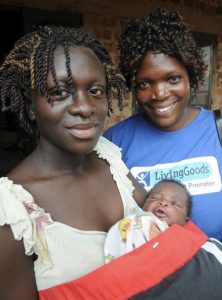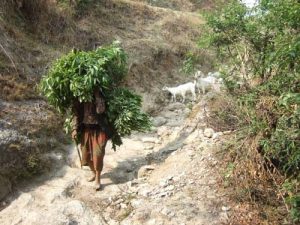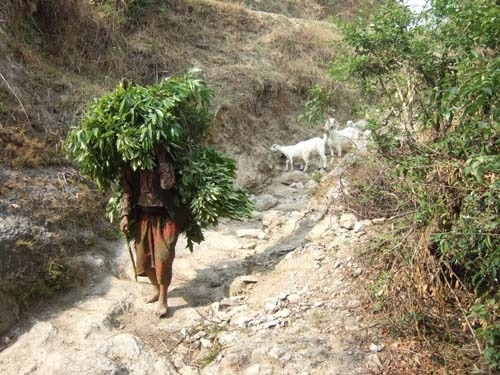
Developing practical and profitable new ways to cross the last 500 feet to the remote rural places where poor families now live and work is the first step towards creating vibrant new markets that serve poor customers.
Fortunately, it’s not that difficult to transport 100 kitchen drip kits from Kathmandu to Pokhara on the roof of a bus. The challenge is in getting those kitchen drip kits to the hundred scattered farms in hill villages that are a day’s walk from the nearest road!
From anything including drip irrigation kits, oral rehydration salts, penicillin, and disaster relief food, moving goods and services over the last 500 feet is especially difficult. And the reverse is equally daunting. Moving marketable goods produced by the hands of poor people in remote villages to the town and city markets where they will fetch the best prices is just as difficult.
Moving goods and services across the last 500 feet of the last mile in and out of scattered rural villages is a challenge crying out for practical solutions.
The last mile
I was surprised to learn that the “last mile” concept comes from the telecommunications industry, which has learned that it’s much cheaper to lay a fat cable carrying television and phone signals almost all of the way to the end customer rather than it is to split it up into a multitude of smaller wires that extend directly to individual homes. As it turns out, wireless communication has helped the telecommunications industry address the last mile challenge, but the movement to end rural poverty has found few solutions to the even bigger challenge of crossing the last 500 feet.
Several organizations have developed models that train villagers to market key goods and services to their neighbors. Following are some examples of this approach.

Living Goods
Following the Avon lady model, Chuck Slaughter founded Living Goods, which trains women in Uganda to sell three or four basic medicines to treat poverty-related illnesses such as malaria, diarrhea, worms, and tuberculosis. “We retail a child’s dose of malaria medicine for 75 cents,” Slaughter says. According to Fast Company, Living Goods has trained more than 600 women in Uganda, and some of them are making more than $100 a week (Fast Company Article). Hiring and training villagers to go door to door to sell important products is a rapidly growing strategy for covering the last 500 feet.
BRAC
BRAC (originally, the Bangladesh Rehabilitation Assistance Committee) is the world’s largest nonprofit development organization, with more than 100,000 employees and programs that directly benefit more than 100,000,000 people. In Uganda, BRAC has mobilized 1,880 village women to act as community health volunteers who distribute products such as oral rehydration salts, iodized salts, and antibiotics for a small fee to villagers (BRAC article).
Green Light Planet
Green Light Planet is a for-profit company in India, which recruits village entrepreneurs to sell $18 solar lanterns to replace kerosene lamps in villages “Lighting a billion lives”.
Mom-and-pop stores
Another promising and widely available way to move goods and services across the last 500 feet is to take advantage of the staggering numbers of village mom-and-pop shops that already sell consumer items in every developing country.
According to the most recently available data, there are 638,000 villages in India (where, not so incidentally, some 72 percent of the population still lives). Since each of these villages has two or three small shops and the bigger villages have more than five, it’s reasonable to assume that there are more than two million small rural village shops in India. But as far as I know, nobody has ever counted them. My guess is that there are at least 10 million small shops in small rural villages in developing countries all over the world. There are also small vegetable carts, milk carts, and other kinds of peddlers’ carts bringing goods and services directly to rural homes. Many of these shops are 10 x 10-foot cubicles, with shutters that swing open when the shop opens and can be padlocked when it’s closed. These shops sell items such as cookies, candies, soap, cigarettes, spices, bulk cooking oil, bananas, small flashlights, and a variety of other small consumer goods, sometimes including chilled soda pop.

Since they are already patronized by most poor rural customers in small villages, and can have easy access to bicycle home delivery and pick-up, these small shops are a priceless resource already in place and capable of carrying goods and services across the last 500 feet. But only a tiny percentage of their potential is being utilized.
Since these small shops are within 500 feet of many of the world’s poor customers, village shops could also provide natural collection and aggregation points for goods produced by the hands of villagers. Because daily sales volume at each shop is low, and the shops are widely scattered, most commercial attempts so far to distribute to small shops have failed to be profitable.
Ten million small shops in villages all over the world are waiting for viable business models for distributing a cornucopia of branded, income-generating products and tools for poor customers, and collecting income-generating goods produced by villagers and transporting them to markets in cities and towns where they can be sold profitably.


The last section of this post – connecting life-improving technologies to local, mom-and-pop retail shops – is exactly what Essmart Global (a social enterprise co-founded by myself, Diana Jue, and Taylor Matthews) does in southern India.
Essmart (www.essmart-global.com) focuses entirely on the marking, distribution, and after-sales services needed to connecting a catalogue of life-improving technologies to local retail shops. We currently operate 3 distribution centers in Tamil Nadu, and have built a network of around 100 local retail shops that distribute a catalogue of over 20 products.
Diana and I have each done over 7 years of research into the tech dissemination space before designing Essmart’s model, and I wanted to provide a few additional thoughts on this subject.
1. In regards to your statement that recruiting village shops can solve last-mile distribution — if only “recruiting shops” was that simple! Last-mile distribution is, in fact, about more than the physical movement of goods. It’s just as much about building trust, providing after-sales service, creating space on the shelves for your products, and a number of other elements. One of the challenges that anyone trying to build a network of local shops faces is understanding how to both recruit and sustain shops. Essmart’s model certainly isn’t perfect, but we understand the importance of focusing on customer acquisition from the shop’s perspective (not just from the end user’s).
2. You mentioned that daily sales volumes at each shop is low. In fact, we have found just the opposite – shop owners (at least in our region) are often very busy and getting their attention can be one of the biggest challenges. This goes back to my above point that understanding that the shops are your customers in a model like ours is absolutely key.
3. Your estimates of around 2M local shops (often called kirana stores) in India is actually quite low – our research found numbers ranging from 12M to 18M in India alone (we typically use “14M local kirana shops”, which is a number we’ve seen repeated several times).
If you’d like to learn more about Essmart, here’s a few articles written on or by us:
a. A Fast Company article about Essmart’s model from when we first got started: http://www.fastcoexist.com/1680135/innovating-the-process-of-getting-technology-to-people-who-need-it
b. A NextBillion post by me and Diana about our backgrounds, research, and how we settled on Essmart’s model: http://www.nextbillion.net/blogpost.aspx?blogid=2929
c. Diana reflects on lessons learned and the other elements of distribution besides merely moving goods in the Stanford Social Innovation Review: http://www.ssireview.org/blog/entry/quality_distribution_for_commercial_success
Jackie — Thank you so much for your comment! I’ll pass it along to Paul as soon as I finish this response.
So, you’re graduates of the Amy Smith school of BOP entrepreneurship? Good for you! Paul and I devote a chapter in our book to one of Amy’s projects.
Essmart sounds great! We’ll be paying attention to you.
You note that enlisting kirana shops is challenging. That’s true, of course. The approach that Paul takes in Spring Health, which is in operation in Odisha (Orissa), may be worth considering. The company first sends a 3-person team into a village to sit down with the elders (members of the Panchayat) and elicit a recommendation from them as to which of the several local shops would be best to do business with. Then, with the support of the elders, the team’s approach to the shop owner gets immediate attention, regardless of how busy she or he might be.
Your comments about the numbers of Kirana shops in India are interesting. We, too, have heard much bigger numbers — 10M, most frequently. But I suspect that counts the huge numbers of such shops in urban areas. We’re referring only to those in India’s 680,000 villages.
BTW, I too have spent some time in Tamil Nadu, though almost exclusively in Madurai and (less frequently) in Chennai. But that was in a previous life, when I worked on fundraising with NGOs. That incarnation drew to a close several years ago.
Please stay in touch!
Mal Warwick
Thanks for your response, Mel! (and sorry for the delayed response on my part – I tried to disconnect a bit for the holiday weekend).
Yes, Amy Smith and D-Lab introduced both Diana and I to this space in undergrad. We like to say that she derailed our career paths in the best possible way (she’s very good at doing this!).
I had heard a bit about Spring Health, but I didn’t know a ton about their approach to working with kirana shops. Thanks for sharing, we’ll see if that technique makes sense to test out in our region!
Re: the number of kirana shops, that does makes sense. We operate in both peri-urban and rural areas, so we’re interested in some of the shops that fall into those larger numbers (not just the village-level shops).
And if you ever do pass through TN again (or Bangalore), don’t hesitate to let us know! We’d love to keep in touch.
Jacke
In terms of inexpensive motorized transport within that last mile, has there been any research into the Institute for Affordable Transportation and their development the “BUV” … the Basic Utility Vehicle. The BUV is ingenious and their mission embodies your thought processes regarding getting goods and services to those populations at the end of the road! Website is: http://www.drivebuv.org/
Hope this helps! Peter